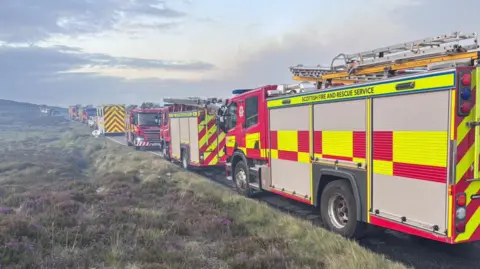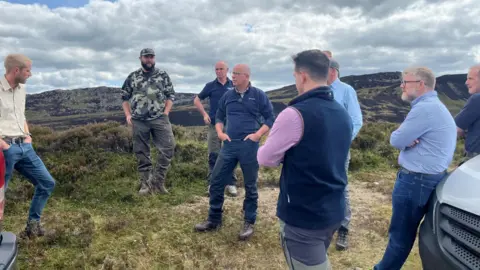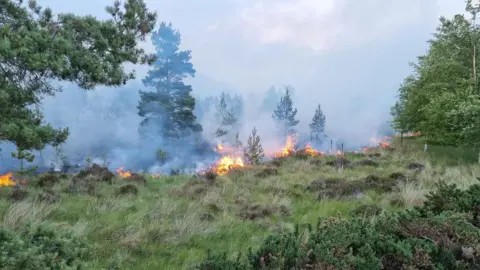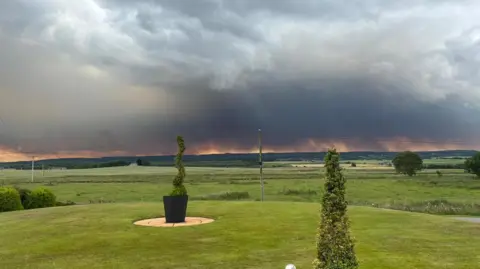Highland wildfires were 'biggest in Scotland's history'
 Nairn Community Fire Station
Nairn Community Fire StationFires that burned across moorland at Carrbridge and Dava in the Highlands recently were the biggest Scotland has ever seen, according to landowners.
Scottish Land and Estates (SLE) estimates the fires that broke out in late June and early July affected 29,225 acres (11,827 hectares) - an area almost 30 times bigger than Lanarkshire's Strathclyde Park.
SLE said at least 101 workers from more than 30 rural businesses assisted dozens of firefighters in tackling the blazes.
A fire at Carrbridge discovered on Friday 20 June re-ignited on multiple occasions times over 11 days before being fully extinguished.
Police and firefighters are continuing to investigate a wildfire that started on Dava Moor on Saturday 28 June.
Ross Ewing, director of moorland at SLE, said the fires had caused "catastrophic damage" to local wildlife and grouse numbers were likely to have been affected.
Dava is a vast moorland used for grazing sheep and grouse shooting. The red grouse shoot traditionally starts on 12 August.
Mr Ewing said: "Many of the affected moorlands provide vital habitat for rare and vulnerable ground-nesting birds, and the fires struck at the worst possible time – just as fledglings were beginning to take flight.
"The loss of this year's young birds will have a long-term impact on already fragile populations."
He said economic consequences would also be "deeply felt".
Mr Ewing said: "Grouse numbers are likely to be significantly reduced, leading to cancelled shoots and a sharp decline in visitors.
"That, in turn, will hit local businesses hard – from accommodation providers and caterers to rural suppliers and contractors who rely on seasonal sporting income."
Controlled fires
Mr Ewing said rural workers should be commended for their efforts.
"The Carrbridge and Dava wildfires represent the largest such event in Scotland's history – and without the extraordinary intervention of rural businesses, the scale of devastation would have been even greater," he said.
Mr Ewing said muirburns, which are controlled fires set to burn off old heather and other vegetation on grouse shooting estates, had a positive impact.
While the main purpose is to encourage new heather growth for grouse and other animals to feed on, it also gets rid of excess vegetation which can fuel wildfires.
However, the practice also has the potential to damage peatlands, which play an important climate role in locking up carbon, and can have a negative impact on other wildlife.
New restrictions on the use of muirburns are due to come in next year.
How are wildfires controlled?

The Scottish Gamekeepers Association's Kenneth Stephen said the use of muirburns had proven crucial in controlling some of the recent fires.
But he told BBC Scotland News: "Where there were no firebreaks and the land was not managed, the wildfire just raged through large areas.
"It becomes too hot and unmanageable that it is not actually safe to put people in there."
He added: "What we want is for the Scottish government to look at the forthcoming muirburn restrictions, due to come into place on 1 January 2026, and realise that they are not going to help prevent wildfire and the loss of peatlands."
Mr Stephen said wildlife was likely to have been affected, including hares, adders and the nests of hen harriers.
Their comments came as Scottish Agriculture Minister Jim Fairlie visited areas affected by the fires.
Speaking earlier on Thursday, he praised the group and members of the Scottish Gamekeepers Association for the role they played in tackling the blazes.
"I am extremely grateful to the SFRS, the Scottish Gamekeepers Association, and others for their hard work and dedication in fighting these fires, and for taking the time to meet with me this week to reflect on that experience and lessons we can learn for future incidents," he said.
 Carrbridge Community Fire Station
Carrbridge Community Fire Station Heartland/BBC Weather Watchers
Heartland/BBC Weather WatchersWhat causes wildfires?
The fire service classifies wildfires as large, uncontrolled outdoor fires exceeding 1,000 sq m of burned area.
It says these fires are unplanned, uncontrolled and unpredictable, and occur in areas with combustible vegetation that can fuel rapid spread.
Human activity is often to blame with fires started by barbecues, glass bottles magnifying sunlight on dry vegetation and discarded cigarettes.
One of the reasons fires continued to burn on moorland was because of its peaty soil which fuels the flames.
The incidents at Dava and Carrbridge resulted in closures of local roads and nearby residents being told to keep windows of homes and businesses closed due to smoke.
BBC Weather Watchers reported smoke from the wildfire near Carrbridge in the Highlands drifting for 40 miles (64km) across the Moray Firth.
But residents in Orkney have also reported smelling smoke carried miles north on the wind.
Moray Scottish Greens councillor Draeyk Van Der Horn also photographed smoke from a number of wildfires visible from a summit in the Cairngorms.
Early morning and evening skies over parts of north Scotland were tinged orange by wildfire smoke.
Meanwhile, SFRS said it was back at Dava Moor on Wednesday.
A spokesperson told BBC Scotland News: "We were alerted at 19:20 to reports of a fire in the open affecting heather and trees along the A940 near Dava.
"Operations control mobilised six appliances, which included a water carrier, to make the area safe.
"Firefighters are no longer at the scene."
In a separate incident, firefighters tackled a large wildfire near Dallas in Moray.
A helicopter was brought in to help extinguish the flames.
All the incidents came during a spell of warm, dry weather.
